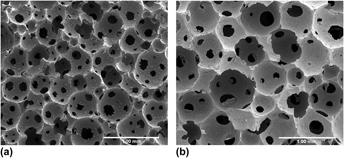Article contents
Effect of activated carbon particle size on the thermo-foaming of aqueous sucrose resin and properties of the carbon foams
Published online by Cambridge University Press: 21 October 2014
Abstract

The carbon foams prepared by the thermo-foaming of dispersions of activated carbon (AC) powder of various average particle sizes (4.9 to 15 μm) in an aqueous sucrose resin were characterized. The stability of the wet foams increased with the decrease in the AC particle size as finer particles preferentially adsorbed on the air–resin interface. The particle agglomeration leading to the foam collapse was observed at lower AC powder to sucrose weight ratios with the finer powders. The cell size (0.33–2.34 mm), foam density (0.1151–0.2281 g/cm3), and compressive strength (0.16–2.77 MPa) of the carbon foams depend on the AC particle size as well as the AC powder to sucrose weight ratio. The thermal conductivity of the carbon foams (0.036–0.049 W m−1 K−1) was much lower than that of the vitreous carbon foams of similar densities. The foams were fire resistant and amenable to machining with the conventional machines and tool.
- Type
- Articles
- Information
- Journal of Materials Research , Volume 30 , Issue 1: Focus Issue: Soft Nanomaterials , 14 January 2015 , pp. 46 - 54
- Copyright
- Copyright © Materials Research Society 2015
References
REFERENCES
- 5
- Cited by




